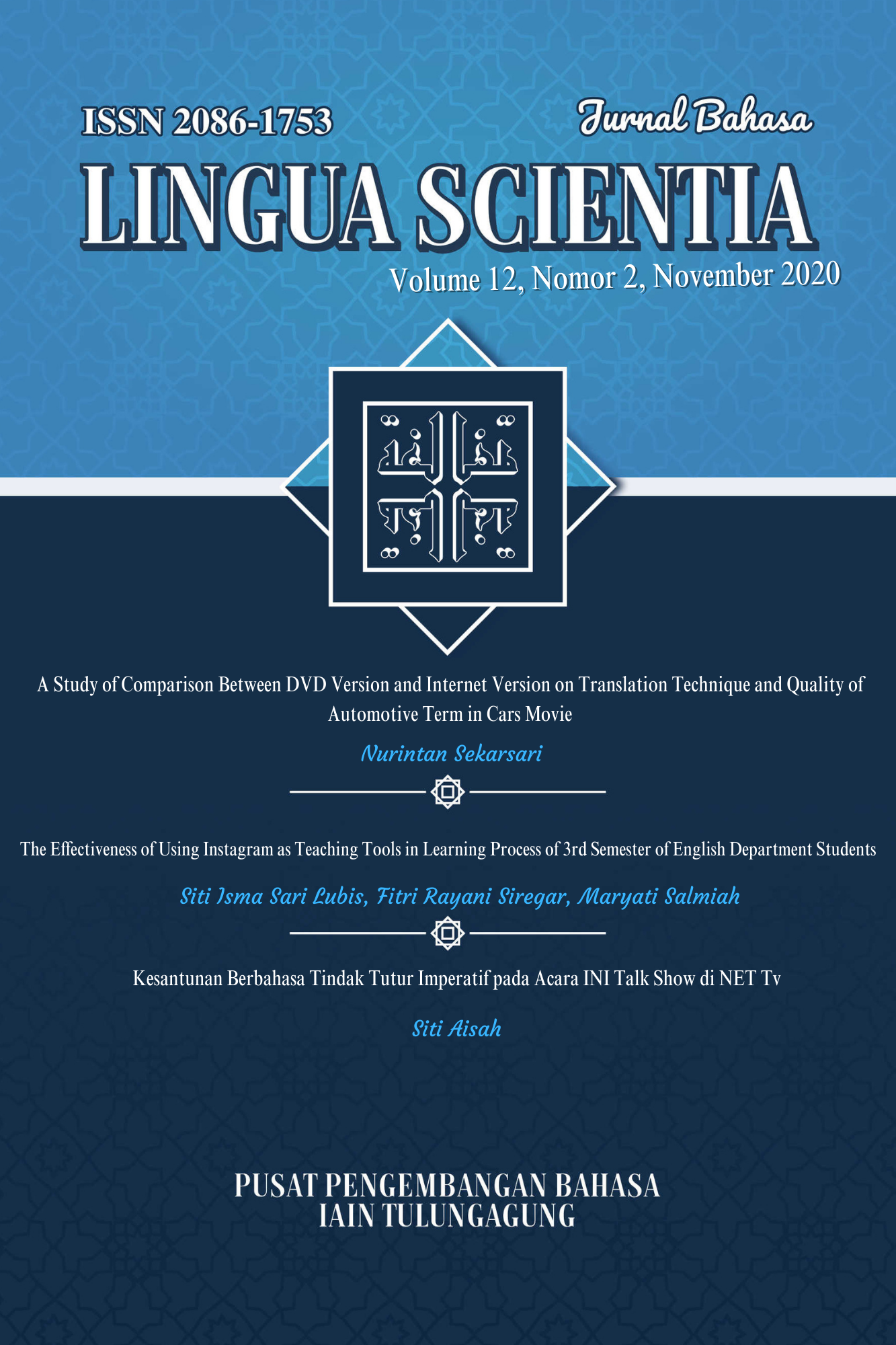KESANTUNAN BERBAHASA TINDAK TUTUR IMPERATIF PADA ACARA INI TALK SHOW DI NET TV
Abstract
The research was distributed by speakers often use the speech act the imperative of using imperative is not directly on the show Talk Show on NET TV. This research was conducted to describe, first, the principle of politeness on the show is a Talk Show, and second; describe the shape of the speech act event is imperative on a Talk Show. This type of research is a qualitative descriptive method. This research instrument is its own researchers assisted with books relating to the research. This research data taken with video how to download this show Talk Show from Youtube Edition January 2016. Based on the results of the study can be summed up as the following things. First, the principle of politeness that is found in the speech act event is imperative on a Talk Show is the tact maxim , generosity maxim, agreement maxim, sympathy maxim. Second, the imperative form of the shareholder said on a Talk Show this event is imperative reigning speech act, telling, asking, pleading, urgent, cajoling, appealed, inviting, call request, permission, permit, prohibition, expectations, and advice.Downloads
References
Brown, P. (2015). Politeness and languange. International Encyclipedia of the Social and Behavioral Sciences 18 (2), 326-330.
Halid, E. (2014). Santun Berbahasa dalam Seminar dan Lokakarya. Padang: Suka Bina Press.
Hamidah, I. (2014). Bertutur santun melalui TTL. Jurnal Izumi 3 (1), 81-91.
Ismawati, E. (2011). Metode Penelitian Pendidikan Bahasa dan Sastra. Surakarta: Yuma Pustaka.
Juita, N. (2016). Tindak tutur tokoh dalam Kaba: mencerminkan kearifan dan kesantunan berbahasa Etnis Minangkabau. Humanus XV (1), 92-104.
Leech, G. (1993). Prinsip-Prinsip Pragmatik. Jakarta: Universitas Indonesia.
Lusiana dan Fitri, N. (2016). Kesantunan tindak tutur imperatif dalam pengajaran Bahasa Inggris pada mahasiswa di Kabupaten Darmasraya. Jurnal Puitika 12 (2), 135-148.
Manaf, N. A. (2011) Kesopanan tindak tutur menyuruh dalam Bahasa Indonesia. LITERA 10 (2), 212-225.
Nababan, P.W.J. (1987). Ilmu Pragmatik: Teori dan Penerapan. Jakarta: Departemen Pendidikan dan Kebudayaan.
Rahardi, K. (2005). Pragmatik Kesatunan Imperatif Bahasa Indonesia. Jakarta: Erlangga.
Ramadhan, S. (2008). Pragmatik Kesantunan Berbahasa Menyibak Penomena Berbahasa Indonesia Guru dan Siswa. Padang: UNP Press.
Rochmawati, D. (2017). Pragmatic and rhetorical strategies in the English – written jokes. Indonesian Journal of Applied linguistics 7 (1), 149-159
Yaolong, S. (2008). A pragmaticstudy of politeness maxims in contemporary Chinese. International Forum of Teaching and Studies 4 (2), 27-59.
Yongliang, H. (2008). Politeness principle in cross-culturecomucation. CCSE 1 (1), 96-101.
Sherry HQ, Agustina, dan Juita, N. (2012). Tindak tutur ilokusi dalam buku humor Membongkar Gurita Cikesa karya Jaim Wong Gendeng dan implikasinya dalam pembelajaran Bahasa Indonesia. Jurnal Pendidikan Bahasa dan Sastra Indonesia 1 (1), 62-70.
Sukarno. (2015). Politeness strategies in responding to compliments in Javanese. Indonesian Journal of Applied Linguistics 4 (2), 91-101.
Susanto, E. (2014). Sikap masyarakat Surabaya terhadap tayangan talk show Hitam-Putih di TRANS TV. E-Komunikasi2(1), 1-12.
Wijana, D. P. (1996). Dasar-Dasar Pragmatik. Yogyakarta: Penerbit ANDI
Copyright (c) 2020 Siti Aisah

This work is licensed under a Creative Commons Attribution-NonCommercial 4.0 International License.
Before going to review process, all manuscripts will be checked that they are free from plagiarism practice using "Turnitin" software. If there is an indication of plagiarism, the manuscript will instantly be rejected.


